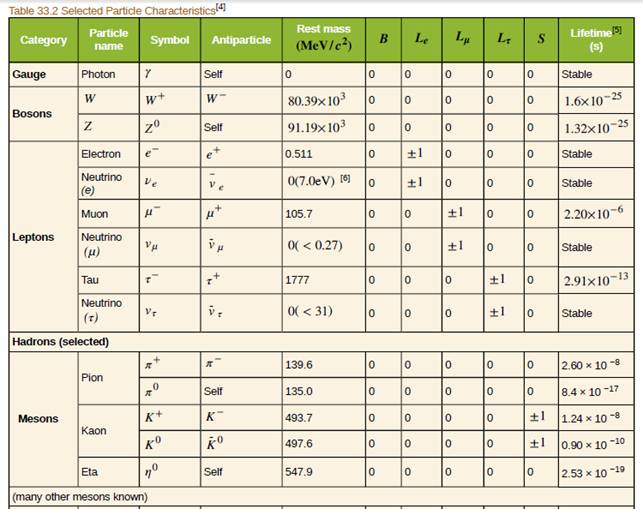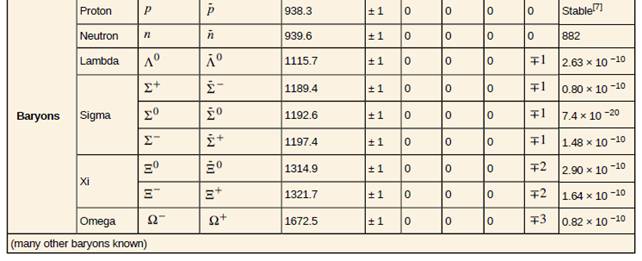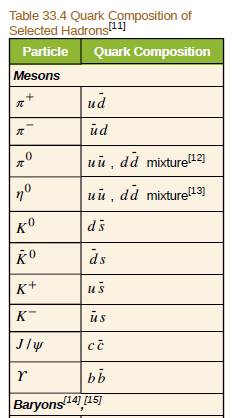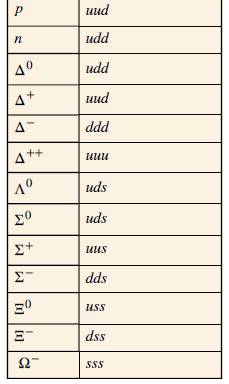
College Physics
1st Edition
ISBN: 9781938168048
Author: Paul Peter Urone, OpenStax, Roger Hinrichs
Publisher: OpenStax
expand_more
expand_more
format_list_bulleted
Concept explainers
Textbook Question
Chapter 33, Problem 36PE
Verify the quantum numbers given for the proton and neutron in Table 33.2 by adding the quantum numbers for their quark constituents as given in Table 33.4.




Expert Solution & Answer
Want to see the full answer?
Check out a sample textbook solution
Students have asked these similar questions
No chatgpt pls will upvote Already
Two objects get pushed by the same magnitude of force. One object is 10x more massive. How does the rate of change of momentum for the more massive object compare with the less massive one? Please be able to explain why in terms of a quantitative statement found in the chapter.
A box is dropped on a level conveyor belt that is moving at 4.5 m/s in the +x direction in a shipping facility. The box/belt friction coefficient is 0.15. For what duration will the box slide on the belt? In which direction does the friction force act on the box? How far will the box have moved horizontally by the time it stops sliding along the belt?
Chapter 33 Solutions
College Physics
Ch. 33 - The total energy in the beam of an accelerator is...Ch. 33 - Synchrotron radiation takes energy from an...Ch. 33 - What two major limitations prevent us from...Ch. 33 - What are the advantages of collidingbeam...Ch. 33 - Large quanti?es of antimatter isolated from normal...Ch. 33 - Massless particles are not only neutral, they are...Ch. 33 - Massless particles must travel at the speed of...Ch. 33 - When a stat erupts in a supernova explosion, huge...Ch. 33 - Theorists have had spectacular success in...Ch. 33 - What lifetime do you expect for an antineutron...
Ch. 33 - Why does the meson have such a short lifetime...Ch. 33 - (a) Is a hadron always a baryon? (b) Is a baryon...Ch. 33 - Explain how conservation of baryon number is...Ch. 33 - The quark ?avor change it takes place in decay....Ch. 33 - Explain how the weak force can change strangeness...Ch. 33 - Beta decay is caused by the weak force, as are all...Ch. 33 - Why is it easier to see the properties of the c,...Ch. 33 - How can quarks, which are fermions, combine to...Ch. 33 - What evidence is cited is support the contention...Ch. 33 - Discuss how we know that (mesons are not...Ch. 33 - An antibaryon has three antiquarks with colors...Ch. 33 - Suppose leptons are created in a reaction. Does...Ch. 33 - How can the lifetime of a particle indicate that...Ch. 33 - (a) Do all particles having strangeness also have...Ch. 33 - The sigmazero particle decays mostly via the...Ch. 33 - What do the quark compositions and other quantum...Ch. 33 - Discuss the similarities and differences between...Ch. 33 - Identity evidence for electroweak unification.Ch. 33 - The quarks in a particle are con?ned, meaning...Ch. 33 - If a GUT is proven, and the four forces are...Ch. 33 - If the Higgs boson is discovered and found to have...Ch. 33 - Gluons and the photon are massless. Does this...Ch. 33 - A virtual particle having an approximate mass of...Ch. 33 - Calculate the mass in of a virtual carrier...Ch. 33 - Another component of the strong nuclear force is...Ch. 33 - (a) Find the ratio of the strengths the weak and...Ch. 33 - We ratio of the strong to the weak force and the...Ch. 33 - At full energy, protons in the 2.00kmdiameter...Ch. 33 - Suppose a W created in a bubble chamber lives for...Ch. 33 - What length track does a (+ traveling at 0.100 c...Ch. 33 - The 3.20kmlong SLAC produces a beam of 50.0GeV...Ch. 33 - Because of energy loss due to synchrotron...Ch. 33 - A proton and an antiproton collide headon, with...Ch. 33 - When an electron and positron collide at the SLAC...Ch. 33 - The is its own antiparticle and decays in the...Ch. 33 - The primary decay mode for the negative pion is...Ch. 33 - The mass of a theoretical particle that may be...Ch. 33 - The decay mode of the negative muon is (a) Find...Ch. 33 - The decay mode of the positive tau is (a) What...Ch. 33 - The principal decay mode at the sigma zero is (a)...Ch. 33 - (a) What is the uncertainty in the energy released...Ch. 33 - (a) What is the uncertainty in the energy released...Ch. 33 - (a) Verify from its quark composition that the...Ch. 33 - Accelerators such as the Triangle Universities...Ch. 33 - The reaction (described in the preceding problem)...Ch. 33 - One of the decay modes of the omega minus is (a)...Ch. 33 - Repeat the previous problem for the decay modeCh. 33 - One decay mode for the etazero meson is (a) Find...Ch. 33 - One decay mode for the etazero meson is (a) Write...Ch. 33 - Is the decay possible considering the appropriate...Ch. 33 - Is the decay possible considering the appropriate...Ch. 33 - (a) Is the decay possible considering the...Ch. 33 - (a) Is the decay possible considering the...Ch. 33 - The only combination of quark colors that produces...Ch. 33 - (a) Three quarks form a baryon. How many...Ch. 33 - (a) Show that the conjectured decay of the proton,...Ch. 33 - Verify the quantum numbers given for the + in...Ch. 33 - Verify the quantum numbers given for the proton...Ch. 33 - (a) How much energy would be released if the...Ch. 33 - (a) Find the charge, baryon number, strangeness,...Ch. 33 - There are particles called Dmesons. One of them is...Ch. 33 - There are particles called bottom mesons or...Ch. 33 - (a) What particle has the quark composition u-u-d?...Ch. 33 - (a) Show than all combinations of three quarks...Ch. 33 - Integrated Concepts The intensity of cosmic ray...Ch. 33 - Integrated Concepts Assuming conservation of...Ch. 33 - Integrated Concepts What is the wavelength of a...Ch. 33 - Integrated Concepts Calculate the relativistic...Ch. 33 - Integrated Concepts The primary decay mode for the...Ch. 33 - Integrated Concepts Plans for an accelerator that...Ch. 33 - Integrated Concepts Suppose you are designing a...Ch. 33 - Integrated Concepts In supernovas, neutrinos are...Ch. 33 - Construct Your Own Problem Consider an...Ch. 33 - Construct Your Own Problem Consider a detector...
Additional Science Textbook Solutions
Find more solutions based on key concepts
Body, Heal Thyself The precision of mitotic cell division is essential for repairing damaged tissues like those...
Biology: Life on Earth with Physiology (11th Edition)
21. Two -diameter aluminum electrodes are spaced apart.
The electrodes are connected to a battery.
...
Physics for Scientists and Engineers: A Strategic Approach, Vol. 1 (Chs 1-21) (4th Edition)
1. Why is the quantum-mechanical model of the atom important for understanding chemistry?
Chemistry: Structure and Properties (2nd Edition)
What two body structures contain flexible elastic cartilage?
Anatomy & Physiology (6th Edition)
Endospore formation is called (a) _____. It is initiated by (b) _____. Formation of a new cell from an endospor...
Microbiology: An Introduction
2. What are the primary functions of the skeletal system?
Human Anatomy & Physiology (2nd Edition)
Knowledge Booster
Learn more about
Need a deep-dive on the concept behind this application? Look no further. Learn more about this topic, physics and related others by exploring similar questions and additional content below.Similar questions
- Plz solution should be complete No chatgpt pls will upvote .arrow_forwardA box with friction coefficient of 0.2 rests on a 12 foot long plank of wood. How high (in feet) must one side of the plank be lifted in order for the box to begin to slide?arrow_forwardWhat is a good general rule to follow in order to find the best choice of coordinate system to solve a dynamics problem?arrow_forward
- What is the meaning of a first order approximation?arrow_forwardNo chatgpt pls will upvote Already got wrong chatgptarrow_forwardA hydrogen atom has just a single electron orbiting the nucleus, which happens to be a single proton without any neutrons. The proton is positively charged, the electron negatively, but both with the same magnitude of charge given by e=1.602x10-19C. The mass of an electron is 9.11x10-31kg, and the proton is 1.67x10-27kg. Find the ratio of the electrostatic to the gravitational force of attraction between the electron and the proton in hydrogen. \arrow_forward
- What is the third law pair to the normal force as you sit in a chair? What effect does the sun's pull on earth have in terms of third law pairs?arrow_forwardUsing Newton's 2nd law, show that all objects subject to the pull of gravity alone should fall at the same rate. What is that rate?arrow_forwardNo chatgpt pls will upvotearrow_forward
arrow_back_ios
SEE MORE QUESTIONS
arrow_forward_ios
Recommended textbooks for you
 Modern PhysicsPhysicsISBN:9781111794378Author:Raymond A. Serway, Clement J. Moses, Curt A. MoyerPublisher:Cengage Learning
Modern PhysicsPhysicsISBN:9781111794378Author:Raymond A. Serway, Clement J. Moses, Curt A. MoyerPublisher:Cengage Learning Principles of Physics: A Calculus-Based TextPhysicsISBN:9781133104261Author:Raymond A. Serway, John W. JewettPublisher:Cengage Learning
Principles of Physics: A Calculus-Based TextPhysicsISBN:9781133104261Author:Raymond A. Serway, John W. JewettPublisher:Cengage Learning College PhysicsPhysicsISBN:9781938168000Author:Paul Peter Urone, Roger HinrichsPublisher:OpenStax College
College PhysicsPhysicsISBN:9781938168000Author:Paul Peter Urone, Roger HinrichsPublisher:OpenStax College College PhysicsPhysicsISBN:9781305952300Author:Raymond A. Serway, Chris VuillePublisher:Cengage Learning
College PhysicsPhysicsISBN:9781305952300Author:Raymond A. Serway, Chris VuillePublisher:Cengage Learning College PhysicsPhysicsISBN:9781285737027Author:Raymond A. Serway, Chris VuillePublisher:Cengage Learning
College PhysicsPhysicsISBN:9781285737027Author:Raymond A. Serway, Chris VuillePublisher:Cengage Learning Glencoe Physics: Principles and Problems, Student...PhysicsISBN:9780078807213Author:Paul W. ZitzewitzPublisher:Glencoe/McGraw-Hill
Glencoe Physics: Principles and Problems, Student...PhysicsISBN:9780078807213Author:Paul W. ZitzewitzPublisher:Glencoe/McGraw-Hill

Modern Physics
Physics
ISBN:9781111794378
Author:Raymond A. Serway, Clement J. Moses, Curt A. Moyer
Publisher:Cengage Learning

Principles of Physics: A Calculus-Based Text
Physics
ISBN:9781133104261
Author:Raymond A. Serway, John W. Jewett
Publisher:Cengage Learning

College Physics
Physics
ISBN:9781938168000
Author:Paul Peter Urone, Roger Hinrichs
Publisher:OpenStax College

College Physics
Physics
ISBN:9781305952300
Author:Raymond A. Serway, Chris Vuille
Publisher:Cengage Learning

College Physics
Physics
ISBN:9781285737027
Author:Raymond A. Serway, Chris Vuille
Publisher:Cengage Learning

Glencoe Physics: Principles and Problems, Student...
Physics
ISBN:9780078807213
Author:Paul W. Zitzewitz
Publisher:Glencoe/McGraw-Hill